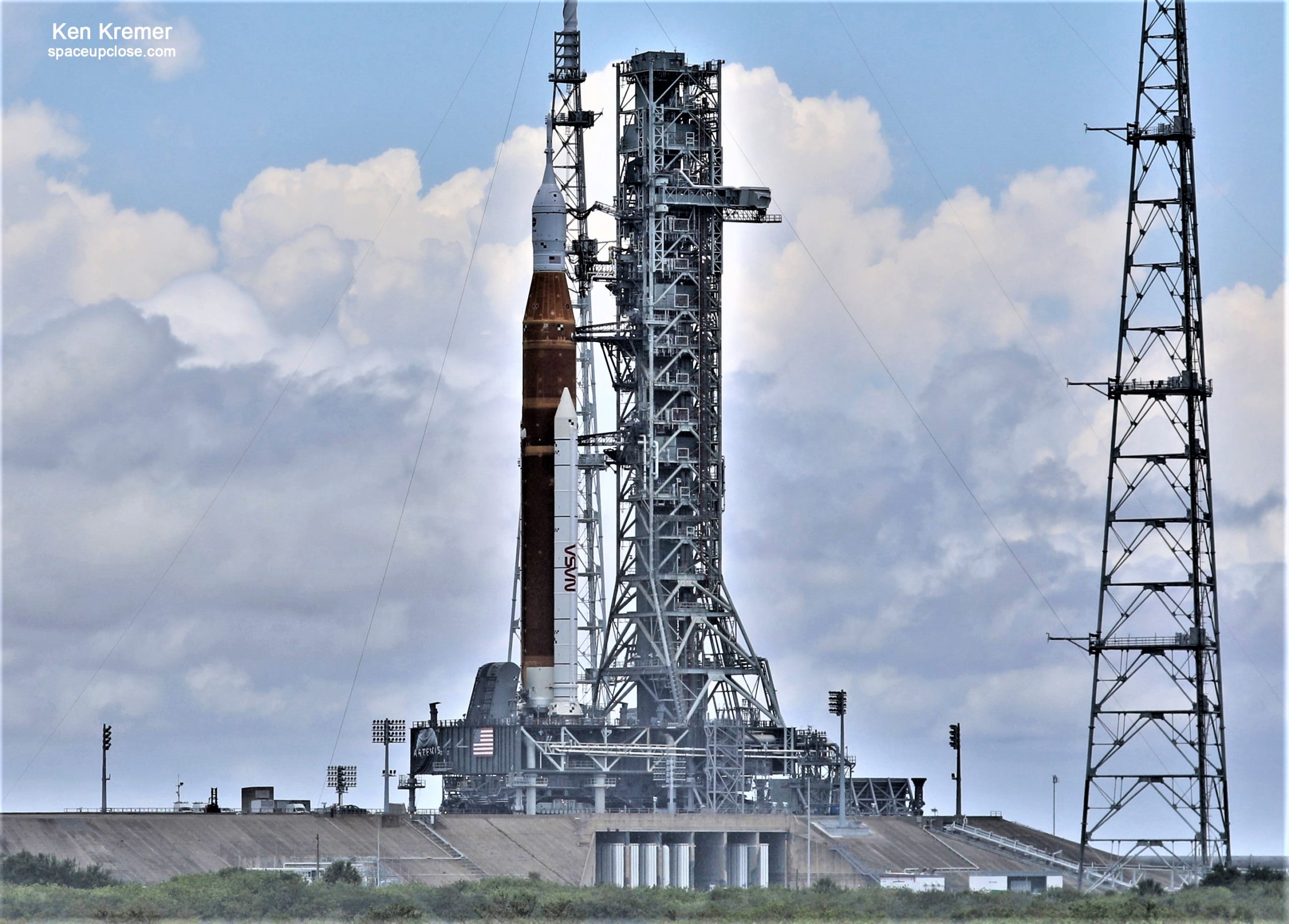
For SpaceUpClose.com & RocketSTEM
KENNEDY SPACE CENTER, FL – The practice countdown has begun for the fourth attempt by NASA to complete the critical countdown and tanking test – known as the Wet Dress Rehearsal (WDR) – for the now repaired SLS Artemis 1 Moon rocket standing vertical at launch pad 39B at NASA’s Kennedy Space Center in Florida.
The WDR practice countdown for the agency’s Space Launch System (SLS) rocket and Orion spacecraft began with a call to stations for the launch team at 5 p.m. Saturday afternoon, June 18.
The countdown test started at 5:30 p.m. Saturday.
The WDR must be completed successfully before NASA can proceed with the actual launch of the SLS/Orion crew module stack on the unpiloted Artemis 1 test flight mission to the Moon and back – now slated for NET no earlier than late August.
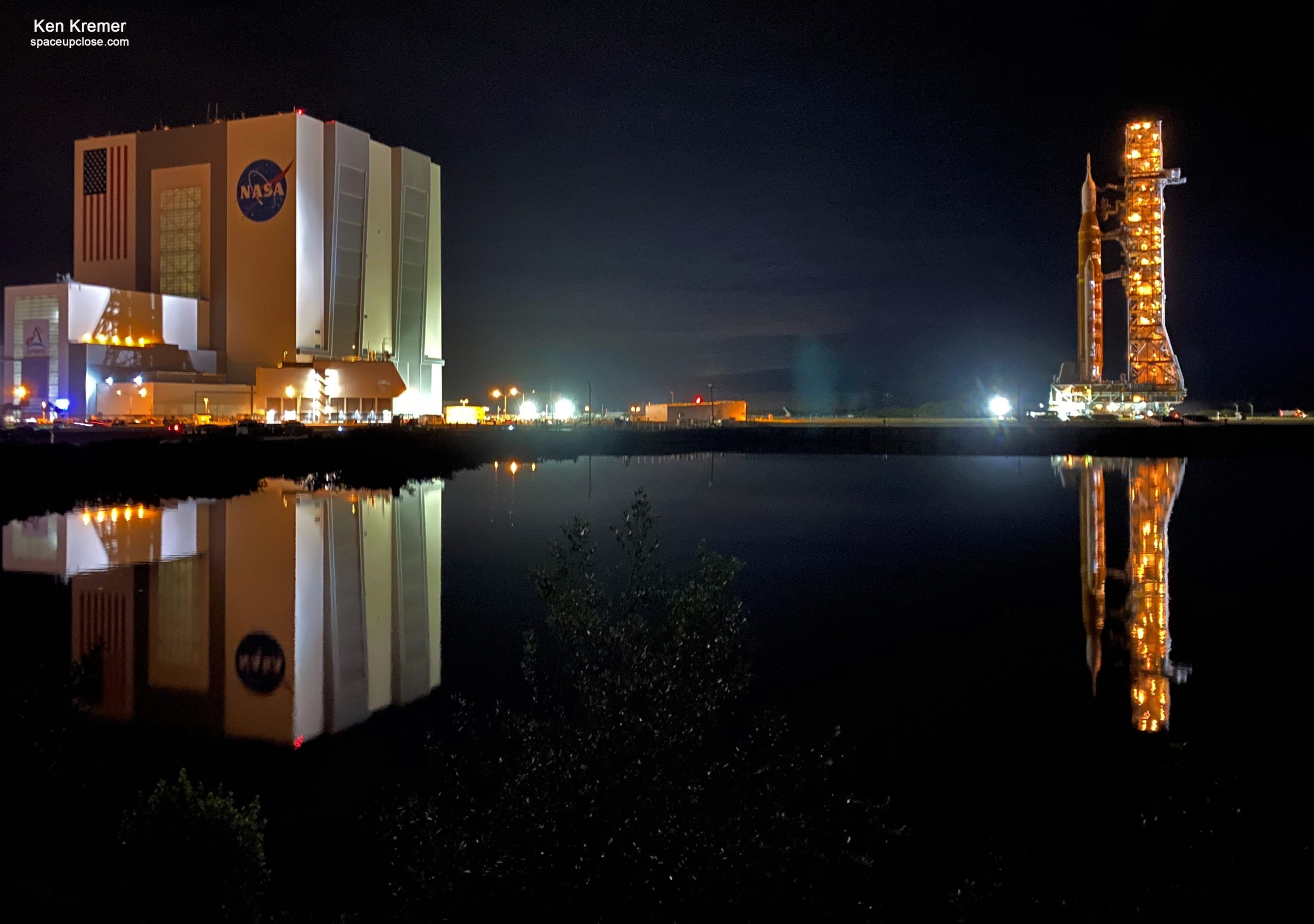
If all goes well it will culminate with completion of the cryogenic loading of liquid oxygen (LOX) and liquid hydrogen (LH2) propellants with a target T-0 Monday afternoon, June 20.
The four core stage engines will not be fired during the countdown test
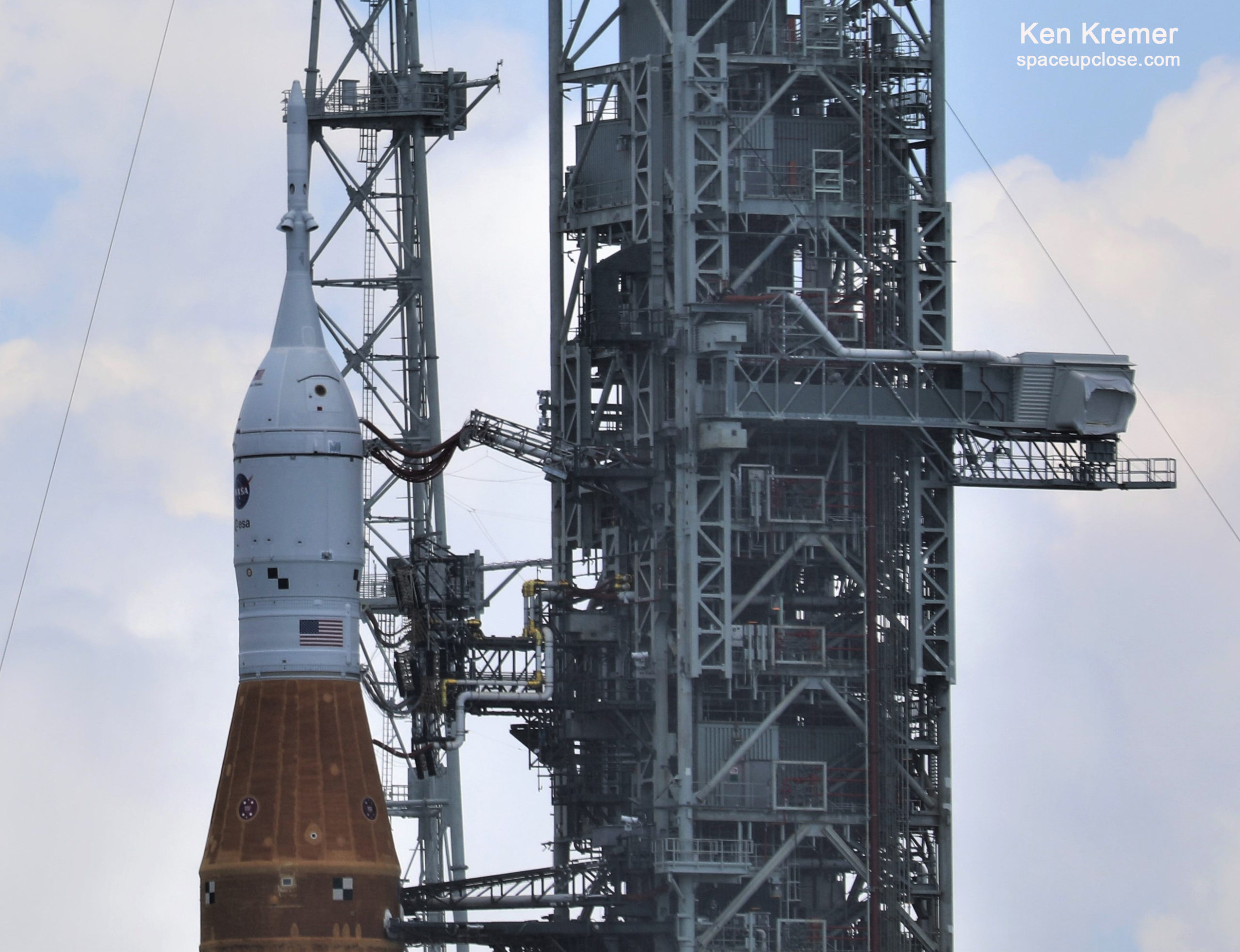
“At approximately 5 p.m. EDT today, the launch team arrived at their stations inside the Launch Control Center at NASA’s Kennedy Space Center in Florida to begin the wet dress rehearsal test for NASA’s Artemis I mission,” NASA officials confirmed in a blog post June 18.
“The countdown began 30 minutes later at 5:30 p.m. or L-45 hours, 10 minutes before the initial target T-0 of 2:40 p.m. on Monday, June 20.
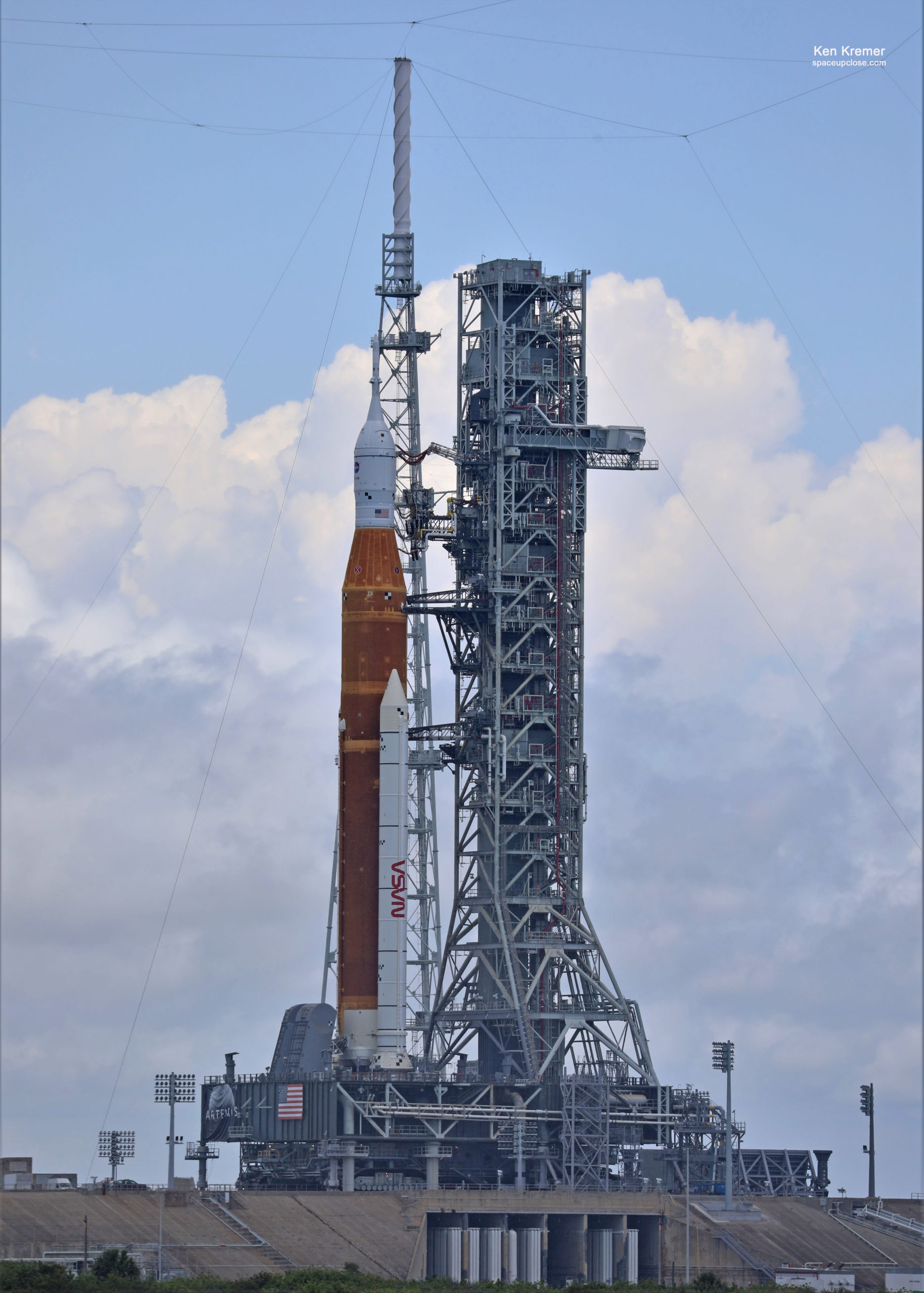
Meteorologists with the U.S. Space Force Space Launch Delta 45 currently predict favorable weather conditions for tanking operations on Monday, June 20.
Weather constraints stipulate there must be less than a 20% chance lightning within 5 nautical miles of the pad during the first hour of tanking. Winds must not be above 37.5 knots and the temperature cannot be below 41 degrees Fahrenheit, says NASA.
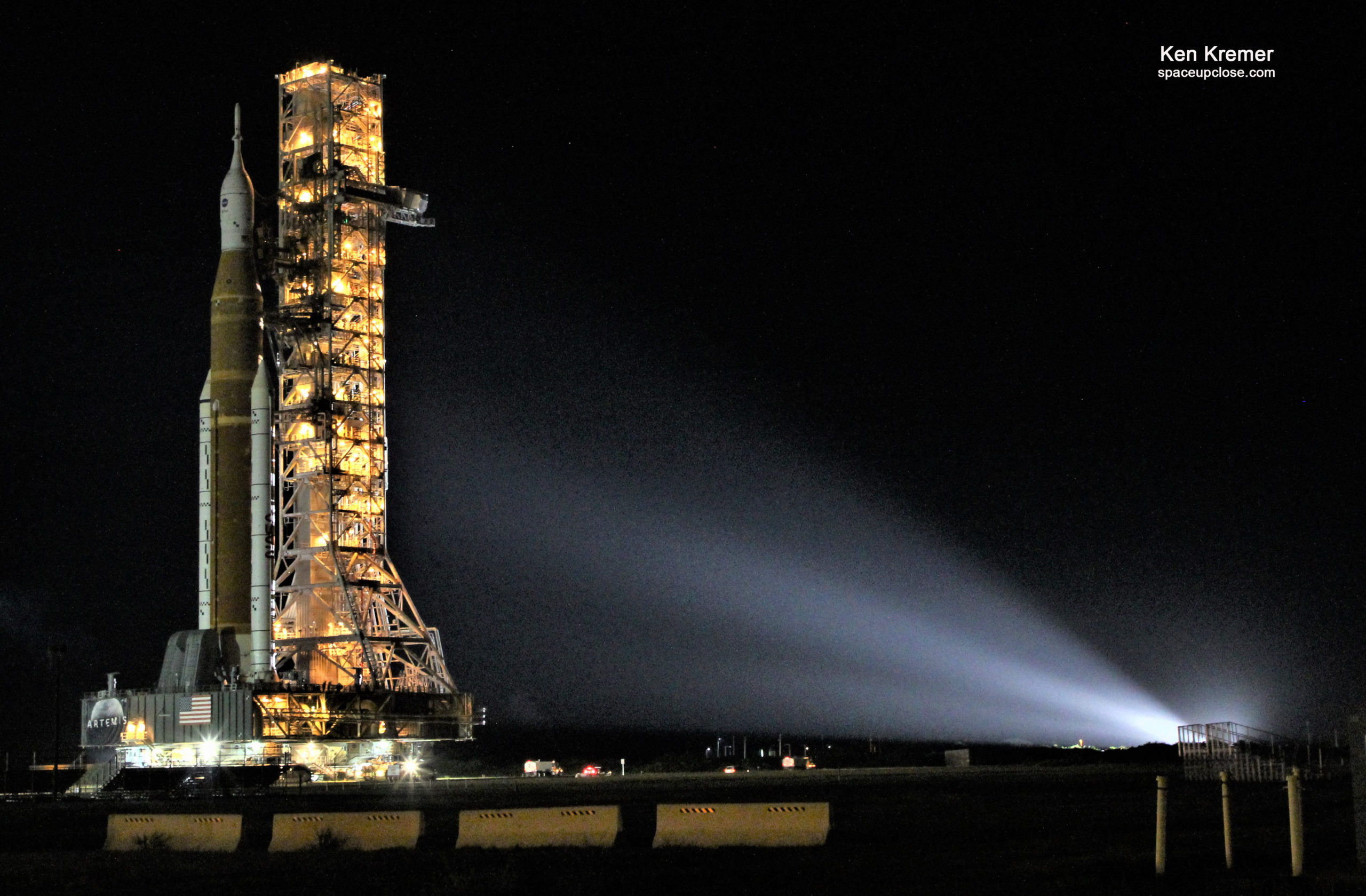
“Tanking begins with chilling down the liquid oxygen lines for the core stage. In sequential fashion, liquid oxygen and liquid hydrogen will flow into the into the rocket’s core stage and interim cryogenic propulsion stage tanks and be topped off and replenished as some of cryogenic propellant boils off. The team also will conduct leak checks to ensure propellant loading is proceeding as expected.”
You can watch the WDR on NASA TV
NASA is streaming live video of the rocket and spacecraft at Launch Pad 39B and providing live commentary on the agency’s website.
Venting may be visible during tanking operations, as I witnessed at the base of the mobile launcher and from the upper stage on the last attempt.
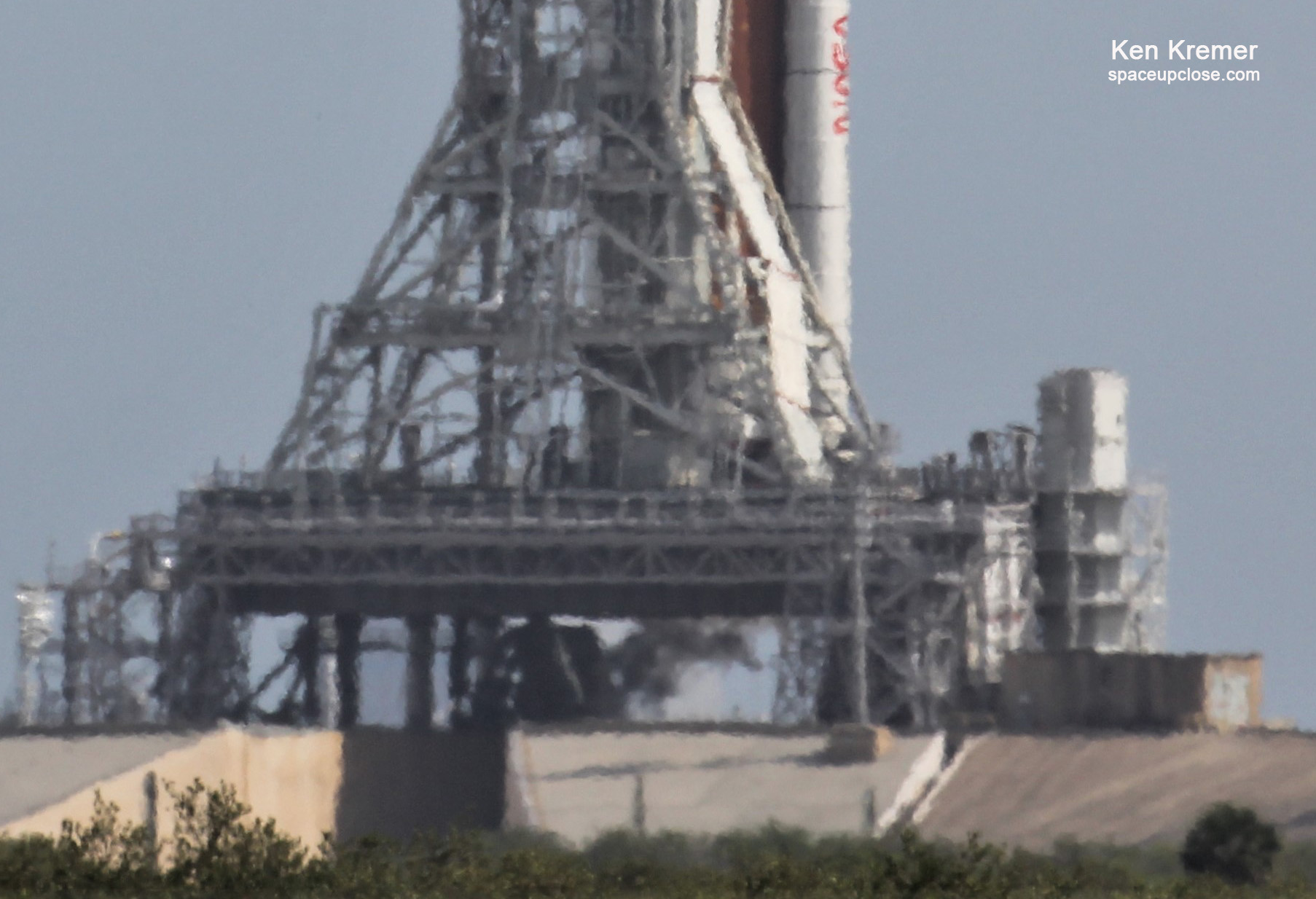
This 2nd transport of SLS from the Vehicle Assembly Building (VAB) to launch pad 39B at NASA’s Kennedy Space Center to Launch Complex 39B started just past midnight on June 6
It followed just over 1 day after the seasons 1st tropical storm hit central and southern Florida – dumping about a foot of heavy flooding rains on the Miami area in particular.
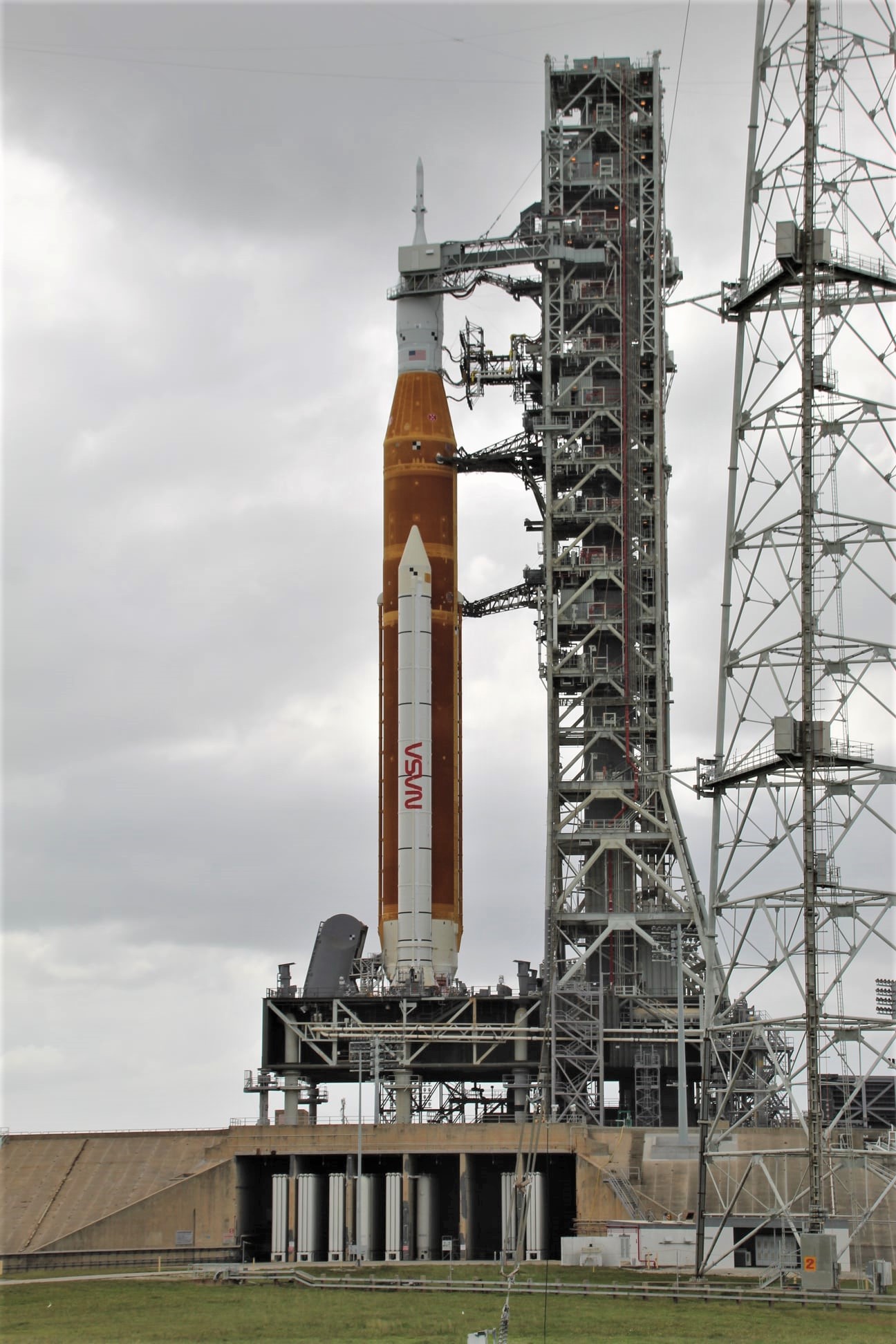
The WDR rehearsal will “run the Artemis I launch team through operations to load propellant into the rocket’s tanks, conduct a full launch countdown, demonstrate the ability to recycle the countdown clock, and also drain the tanks to give them an opportunity to practice the timelines and procedures they will use for launch.”
The WDR rehearsal is the final test needed before Artemis 1 can launch and calls for NASA to load over 750,000 gallons of cryogenic liquid oxygen (LOX) and liquid hydrogen (LH2) propellants into the rocket’s core stage and second stage tanks, conduct a full launch countdown, demonstrate the ability to recycle the countdown clock, and drain the tanks to practice the timelines and procedures that will be used for launch.
The WDR cryogenic fueling and practice countdown test was halted after 3 attempts in April due to technical problems
The rocket was then rolled back to the VAB to carry out the repairs
“While inside the Vehicle Assembly Building (VAB), teams completed several major objectives, including assessing the liquid hydrogen system leak at the tail service mast umbilical, replacing the interim cryogenic propulsion stage (ICPS) gaseous helium system check valve and support hardware, and modifying the ICPS umbilical purge boots. The addition of hazardous gas detectors above the upper stage allows for additional visibility into any potential leaks during cryogenic operations,” NASA reported.
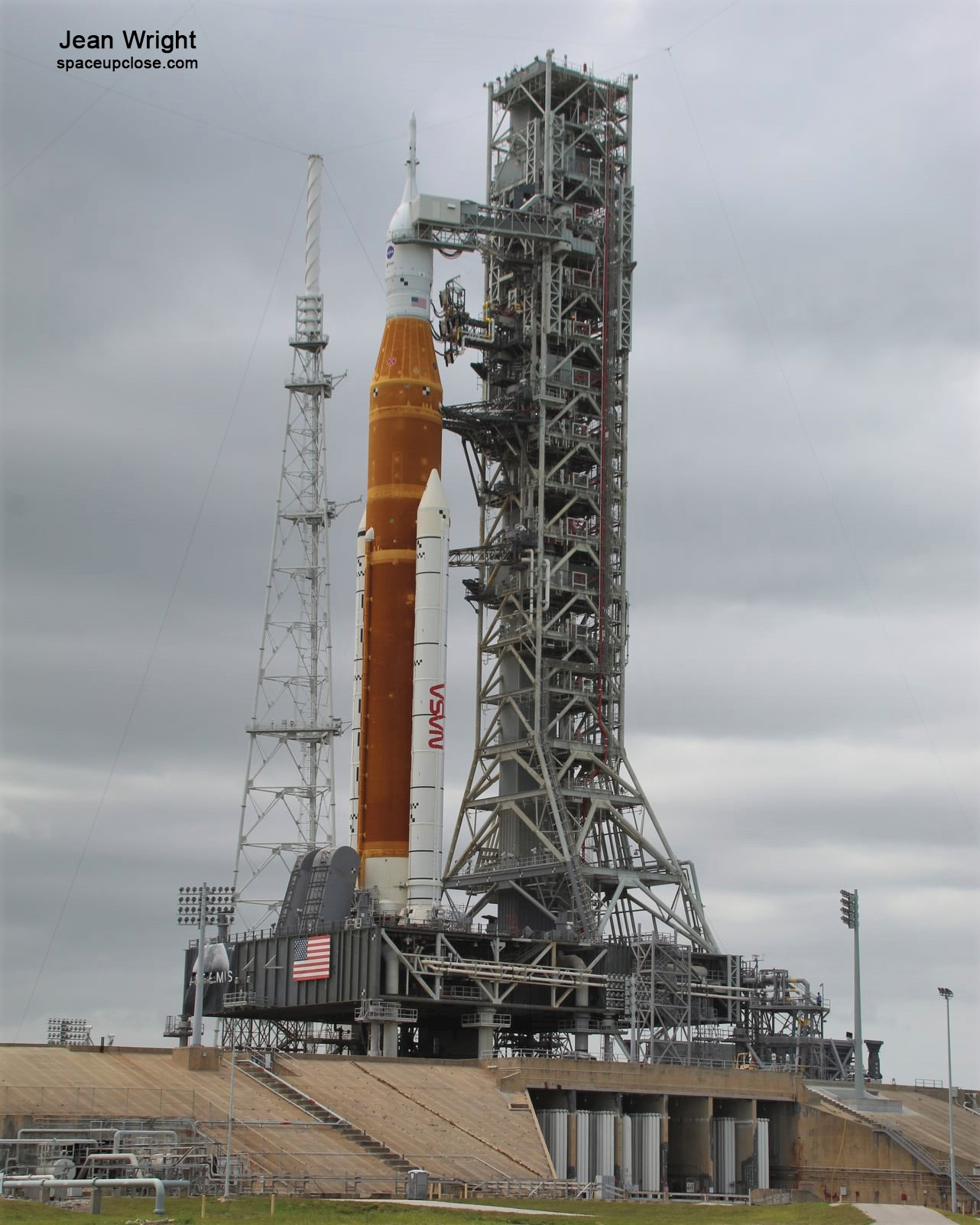
NASA posted a bar chart summary timeline for the WDR:
Here is a detailed WDR explanation and timeline from NASA:
WDR Approximate times for milestones during the test are below. During the test, the timing for some events on account of several planned operational demonstrations tied to specific capabilities and test objectives may differ from the day of launch countdown. These demonstrations include tests on the cryogenic systems and an approximately three-minute hold inside the terminal count, which would not normally occur on launch day. If needed, the test team may also hold as necessary to verify conditions before resuming the countdown, or use the test window or extend beyond it, if consumables and resources allow them to complete test objectives.
Prior to Call to Stations
- The Orion crew module hatch is closed (will occur at ~L-37.5 hours for launch)
- The crew access arm is retracted (will occur at ~L-30 hours for launch)
- Leak checks are completed on the Orion spacecraft and the launch abort system is closed (will occur at ~L-29 hours, 30 minutes for launch)
5 p.m. EDT, June 18 – L-45 hours, 40 minutes and counting
- The launch team arrives on their stations and the countdown begins (L-45, 40 minutes hours)
- Fill the water tank for the sound suppression system (L-45 hours)
- Orion spacecraft power up start (L-41 hours)
- SLS core stage is powered up (L-35 hours, 20 minutes)
- Final preparations of the four RS-25 engines complete (L-30 hours, 30 minutes)
- Engines will not fire during this test
1:40 a.m., June 20 – L-13 hours and counting
- The SLS interim cryogenic propulsion stage (ICPS) is powered up (L-12 hours, 50 minutes)
- All non-essential personnel leave Launch Complex 39B (L-12 hours)
6 a.m. – L-8 hours, 40 minutes and counting
- Built in countdown hold begins and lasts approximately 1.5 hours (L-8 hours, 40 minutes)
- The launch director and mission management team chair conduct a weather and tanking briefing (L-8 hours, 20 minutes)
- The launch director and mission management team chair decide if they are “go” or “no-go” to begin tanking the rocket (L-7 hours, 50 minutes)
6:40 a.m. – L-8 hours and counting
- 7:35 a.m.: Core stage liquid oxygen (LOX) chilldown start (L-7 hours, 05 minutes)
- 8:15 a.m.: Core stage LOX slow fill start (L-6 hours, 25 minutes)
- 8:30 a.m.: Core stage LOX fast fill start (L-6 hours, 10 minutes)
- 8:35 a.m.: Core stage liquid hydrogen (LH2) chilldown start (L-6 hours, 5 minutes)
- 8:40 a.m.: Core stage LH2 slow fill start (L-6 hours)
- 9:00 a.m.: Core stage LH2 fast fill start (L-5 hours, 40 minutes)
10:10 a.m. – L-4 hours, 30 minutes and counting
- 10:10 a.m.: Core stage LH2 topping start (L-4 hours, 30 minutes)
- 10:15 a.m.: ICPS LH2 chilldown (L-4 hours, 25 minutes)
- 10:15 a.m.: Core stage LH2 replenish start (L-4 hours 25 minutes)
- 10:20 a.m.: Orion communications system activation start (L-4 hours, 20 minutes)
- 10:40 a.m.: ICPS LH2 fast fill (L-4 hours)
11:10 a.m. – L-3 hours, 30 minutes and counting
- 11:15 a.m.: Core stage LOX topping start (L-3 hours, 25 minutes)
- 11:20 a.m.: Core stage LOX replenish start (L-3 hours, 20 minutes)
- 11:20 a.m.: ICPS LOX chilldown start (L-3 hours, 20 minutes)
- 11:25 a.m.: ICPS LH2 validation and leak test start (L-3 hours, 15 minutes)
- 11:30 a.m.: ICPS LOX fast fill start (L-3 hours, 10 minutes)
- 11:40 a.m.: ICPS LH2 tanks load topping start (L-3 hours)
- 11:40 a.m.: ICPS/SLS telemetry data verified with Mission Control Center and SLS Engineering Support Center (L-3 hours)
- 12 p.m.: ICPS LH2 replenish start (L-2 hours, 40 minutes)
- 12 p.m.: ICPS LOX validation and leak test (L-2 hours, 40 minutes)
- 12:20 p.m.: ICPS LOX topping start (L-2 hours, 20 minutes)
- 12:30 p.m.: ICPS LOX replenish start (L-2 hours, 10 minutes)
- 12:40 p.m.: WDR-specific core stage LOX/LH2 stop flow and recover test (L-2 hours through L-55 minutes)
2 p.m. – L-40 minutes and holding
- 2 p.m.: Final NASA test director briefing begins
- 2 p.m.: Built in 30-minute countdown hold begins
- 2:25 p.m.: The launch director polls the team to ensure they are “go” for terminal count for test purposes
2:30 p.m. – T-10 minutes and counting (WDR Run 1)
-
- 2:34 p.m.
- Orion ascent pyros are armed (T-6 minutes)
- Orion set to internal power (T-6 minutes)
- Core stage LH2 terminate replenish (T-5 minutes, 57 seconds)
-
-
- 2:36 p.m.
- Core stage auxiliary power unit starts (T-4 minutes)
- Core stage LOX terminate replenish (T-4 minutes)
- ICPS LOX terminate replenish (T-3 minutes, 30 seconds)
-
-
- 2:38 p.m.
- ICPS switches to internal battery power (T-1 minute, 56 seconds)
- Core stage switches to internal power (T-1 minute, 30 seconds)
- 3 minute launch ready hold (T-1 minute, 30 seconds)
- Wet dress rehearsal only
- ICPS enters terminal countdown mode (T-1 minute, 20 seconds)
-
-
-
- 2:41 p.m.
- ICPS LH2 terminate replenish (T-50 seconds)
- Ground launch sequencer sends “cut-off” command (T-33 seconds)
- 2:41 p.m.
-
- 2:38 p.m.
- 2:36 p.m.
- 2:34 p.m.
Perform Critical Safing and Planned Recycle back to T-10 minutes and holding (takes approximately one hour)
T-10 minutes and counting (WDR Run 2)
- Orion ascent pyrotechnics are armed (T-6 minutes)
- Orion set to internal power (T-6 minutes)
- Core stage LH2 terminate replenish (T-5 minutes, 57 seconds)
- Core stage auxiliary power unit starts (T-4 minutes)
- Core stage LOX terminate replenish (T-4 minutes)
- ICPS LOX terminate replenish (T-3 minutes, 30 seconds)
- ICPS switches to internal battery power (T-1 minute, 56 seconds)
- Core stage switches to internal power (T-1 minute, 30 seconds)
- ICPS enters terminal countdown mode (T-1 minute, 20 seconds)
- ICPS LH2 terminate replenish (T-50 seconds)
- Ground launch sequencer sends “Go for automated launch sequencer” command (T-33 seconds)
- Core stage flight computer to automated launching sequencer (T-30 seconds)
- Ground launch sequencer manual cut-off at T-9.34 seconds
Teams will then proceed conducting critical safing and core and upper stage cryogenic fuel drain operations.
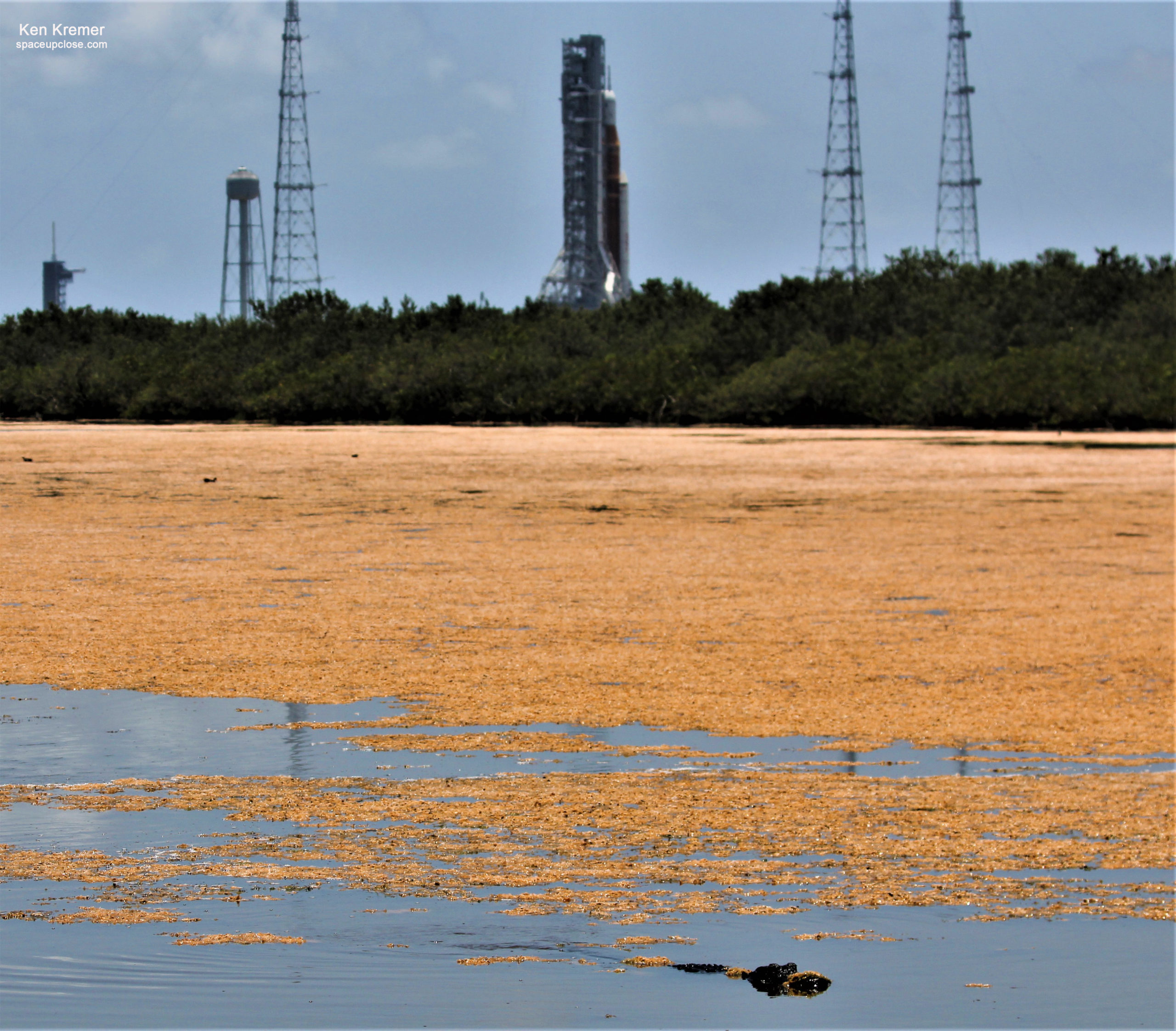
The Space UpClose team of Ken Kremer and Jean Wright attended and witnessed the SLS/Orion 1st and 2nd rollouts from KSC Press Site and also witnessed the rollback return on April 26 to make the required repairs
Enjoy our photos of SLS/Orion rolling out and back between the VAB and pad 39B.
Read my earlier detailed stories about the rollout, rollback and repairs illustrated with our photos
NASA will set a launch date for Artemis 1 only after successfully completing the WDR
After this next WDR the SLS/Orion stack will again be rolled back to the VAB for refurbishments, installation of the FTS and any further repairs and other work needed to ready for the launch campaign
Liftoff is expected NET late August
Watch Ken’s commentary about NASA SLS WDR demo test, SpaceX missions including Nilesat 301, Transporter-5, Boeing Starliner, NASA Crew-3, Crew 4 and SpaceX AX-1 missions and Starlink and NASA TROPICS 1.
Jun 17: Fox 35 Orlando featured my commentary about the selection of 2 NASA astronauts to fly on the 1st crewed mission of Boeing Starliner capsule on CFT test flight late 2022 – and what it means for human spaceflight to have a 2nd US commercial crew provider following the successful Boeing Starliner OFT-2 mission for NASA
Jun 9/10: WFTV ABC Orlando features my commentary about the upcoming NASA TROPICS 1 & 2 cubesat science launch on an Astra Rocket 3.3 from pad 46 for NASA which will study the formation and evolution of Tropical Cyclones and Hurricanes. Two more launches will follow for 6 TROPICS cubesats altogether over next few months
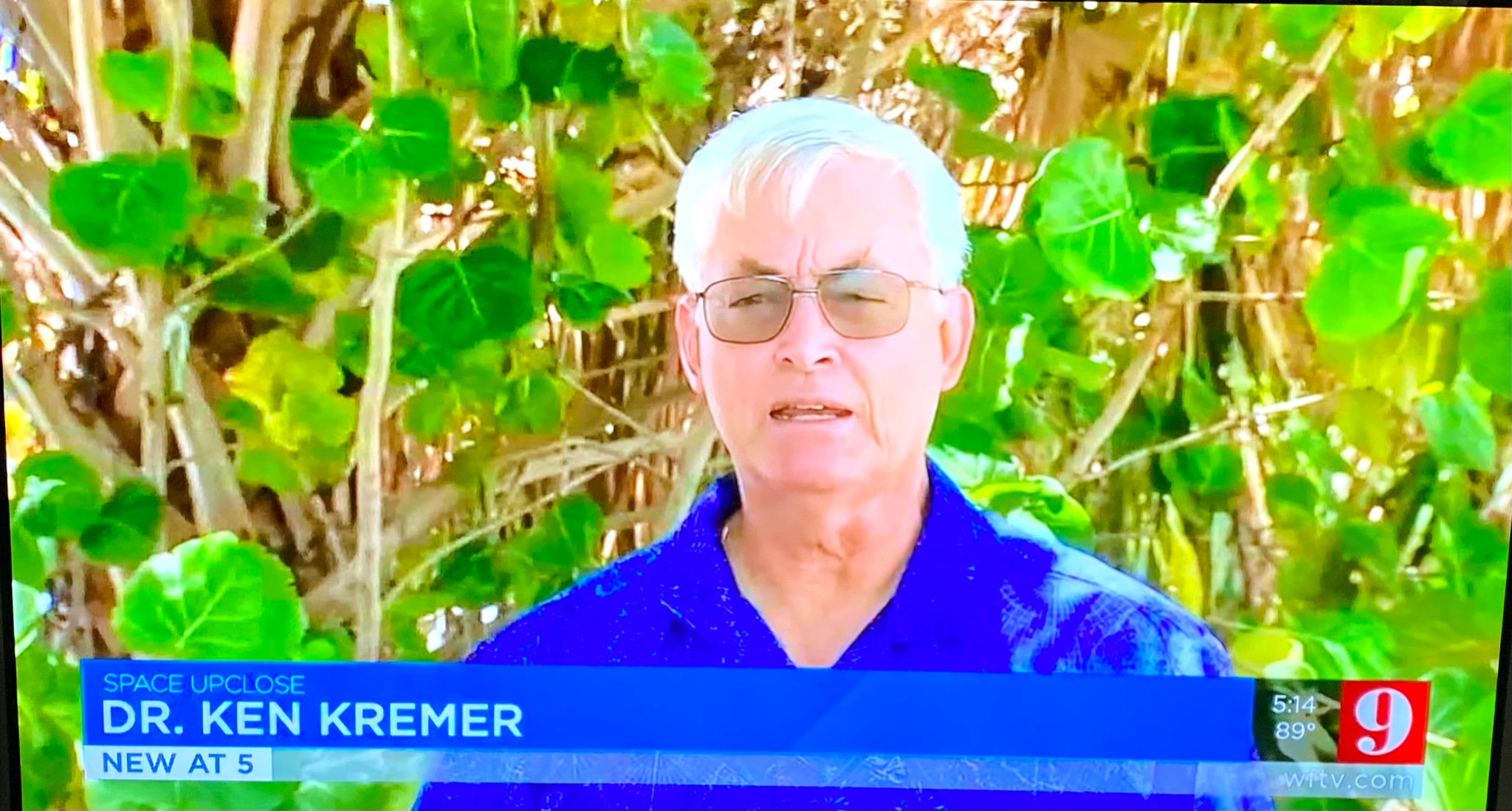
Jun 8: WFTV ABC Orlando features my commentary about the SpaceX Falcon 9 launch of NileSat301 telecom sat for Egypt
June 6/7: WFTV ABC Orlando features my commentary about completing 2nd rollout to pad 39B for 2nd round WDR tanking test, what’s involved in and why its critical to the future of Project Artemis:
May 25/26: WFTV ABC Orlando featured my commentary about the successful ISS undocking and touchdown of Starliner on OFT-2 test flight
May 19/20: WFTV ABC Orlando and Fox 35 Orlando featured my prelaunch and post launch commentary about the critical nature of the Boeing Starliner OFT-2 mission for NASA
May 11: WFTV ABC Orlando News featured my commentary & analysis about Boeing Starliner crew capsule targeting launch May 19 for long delayed OFT2 uncrewed test flight for NASA after completing FRR this afternoon. It must dock at ISS to be considered successful to enable follow-on NASA astronaut flights maybe by late 2022
Apr 29: WKMG CBS 6 with my commentary about the record setting Falcon 9 turnaround of 21 days since the Axiom-1 launch
Apr 22: Fox 35 Orlando features my analysis of the busy week ahead in space with weather delayed Earth return of AX-1 crew this weekend, launch of 4 NASA/ESA Crew-4 astronauts on SpaceX Crew Dragon NET Apr 26 & rollback of NASA SLS to VAB for repairs
https://www.fox35orlando.com/video/1060937
Apr 20: WFTV ABC News Orlando features my commentary about the SpaceX static fire and impact of weather induced delays to departure of Ax-1 and launch of Crew-4.
Apr 15/16 & Apr 12/13: WFTV ABC News Orlando and WKMG CBS 6 Orlando featured my comments about NASA SLS WDR wet dress rehearsal countdown and fueling demo test and human launches to ISS:
Apr 6: WFTV ABC 9 Orlando featured my comments about 1st fully private astronaut launch to ISS by SpaceX on AX-1 mission:https://www.wftv.com/news/local/brevard-county/first-all-private-astronaut-mission-iss-set-liftoff-kennedy-space-center-this-week/FYE5QAT735BA7G42O6IVCJGB4Q/
Apr 4 & 5: WFTV ABC News Orlando and Fox 35 Orlando featured my comments about NASA SLS WDR wet dress rehearsal countdown and fueling demo test and human launches to ISS
https://www.fox35orlando.com/news/nasa-resumes-artemis-i-wet-dress-rehearsal-countdown
Watch Ken’s continuing reports about Artemis, SLS, Orion and NASA missions, SpaceX Crew and Cargo Dragons, SpaceX Axiom-1, JWST, IXPE, DART, Lucy Asteroid mission, GOES, SpaceX Starlink, Commercial Crew and Starliner and Crew Dragon, Blue Origin and Space Tourism, and onsite for live reporting of upcoming and recent SpaceX and ULA launches including Crew 1 & 2 & 3 & 4, ISS, Solar Orbiter, Mars 2020 Perseverance and Curiosity rovers, NRO spysats and national security missions and more at the Kennedy Space Center and Cape Canaveral Space Force Station.
Stay tuned here for Ken’s continuing Earth and Planetary science and human spaceflight news: www.kenkremer.com –www.spaceupclose.com – twitter @ken_kremer – email: ken at kenkremer.com
Dr. Kremer is a research scientist and journalist based in the KSC area, active in outreach and interviewed regularly on TV and radio about space topics.
………….
Ken’s photos are for sale and he is available for lectures and outreach events
Please consider supporting Ken’s work by purchasing his photos and/or donating at Patreon
https://www.patreon.com/kenkremer
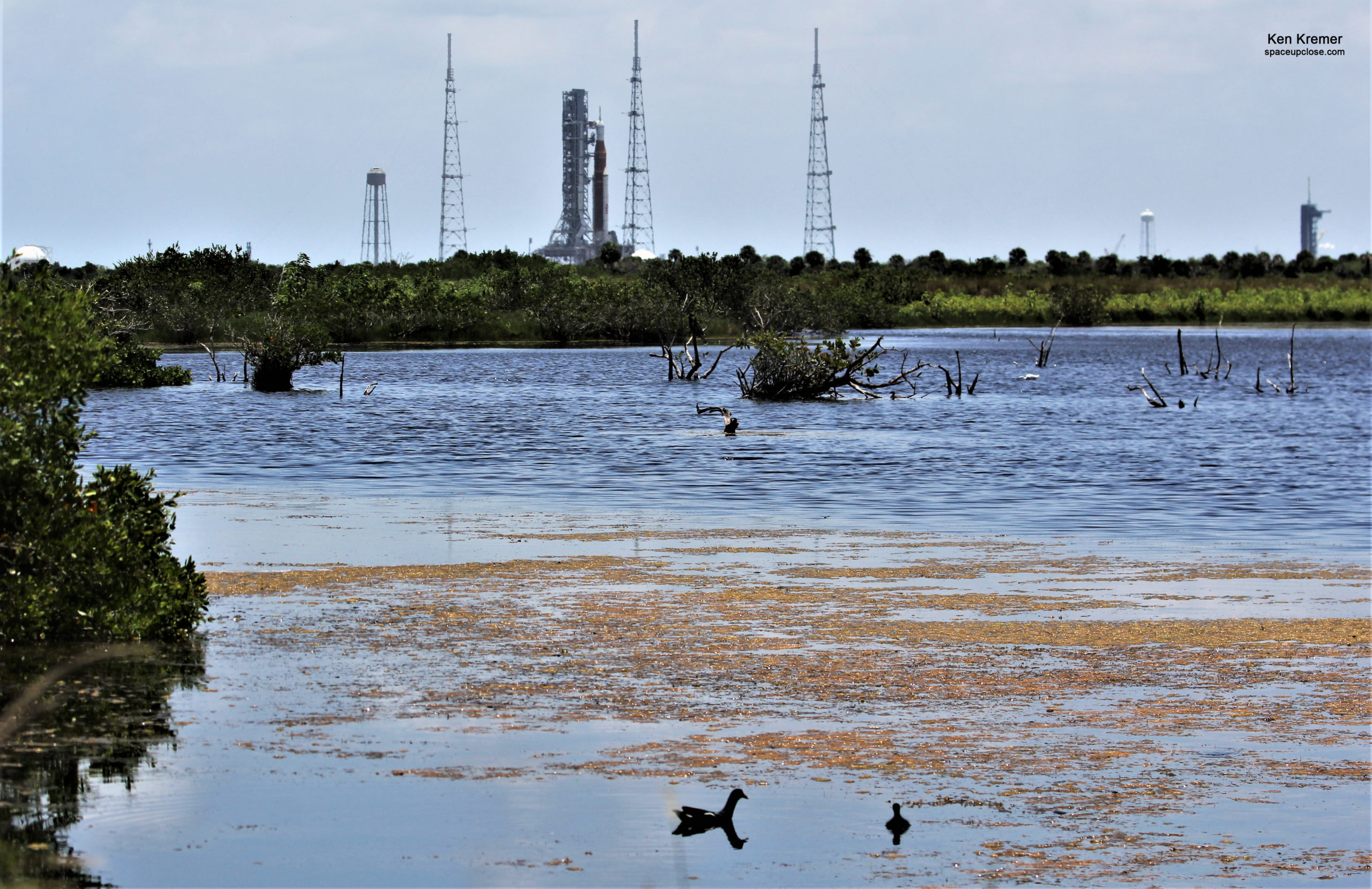
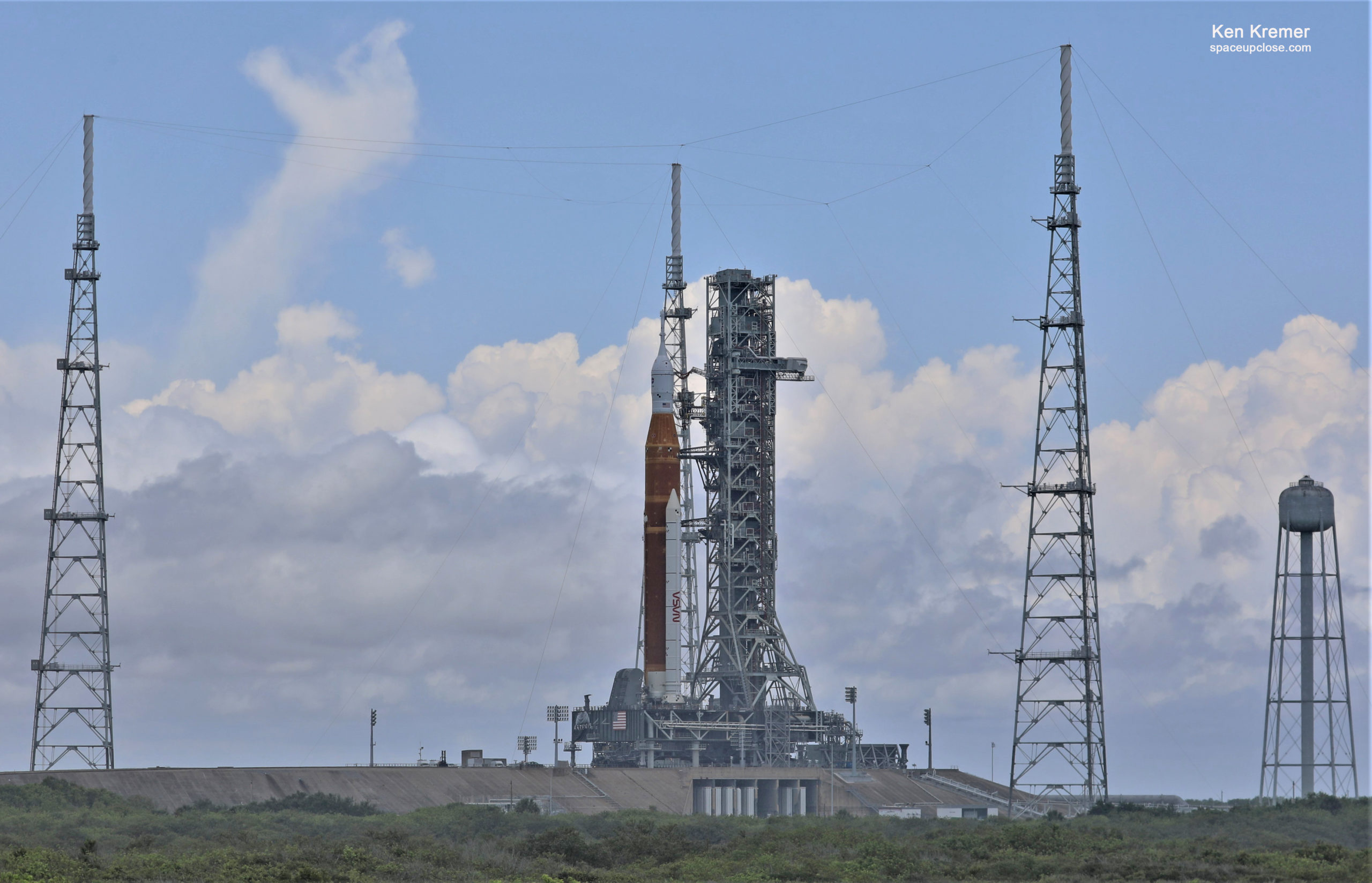
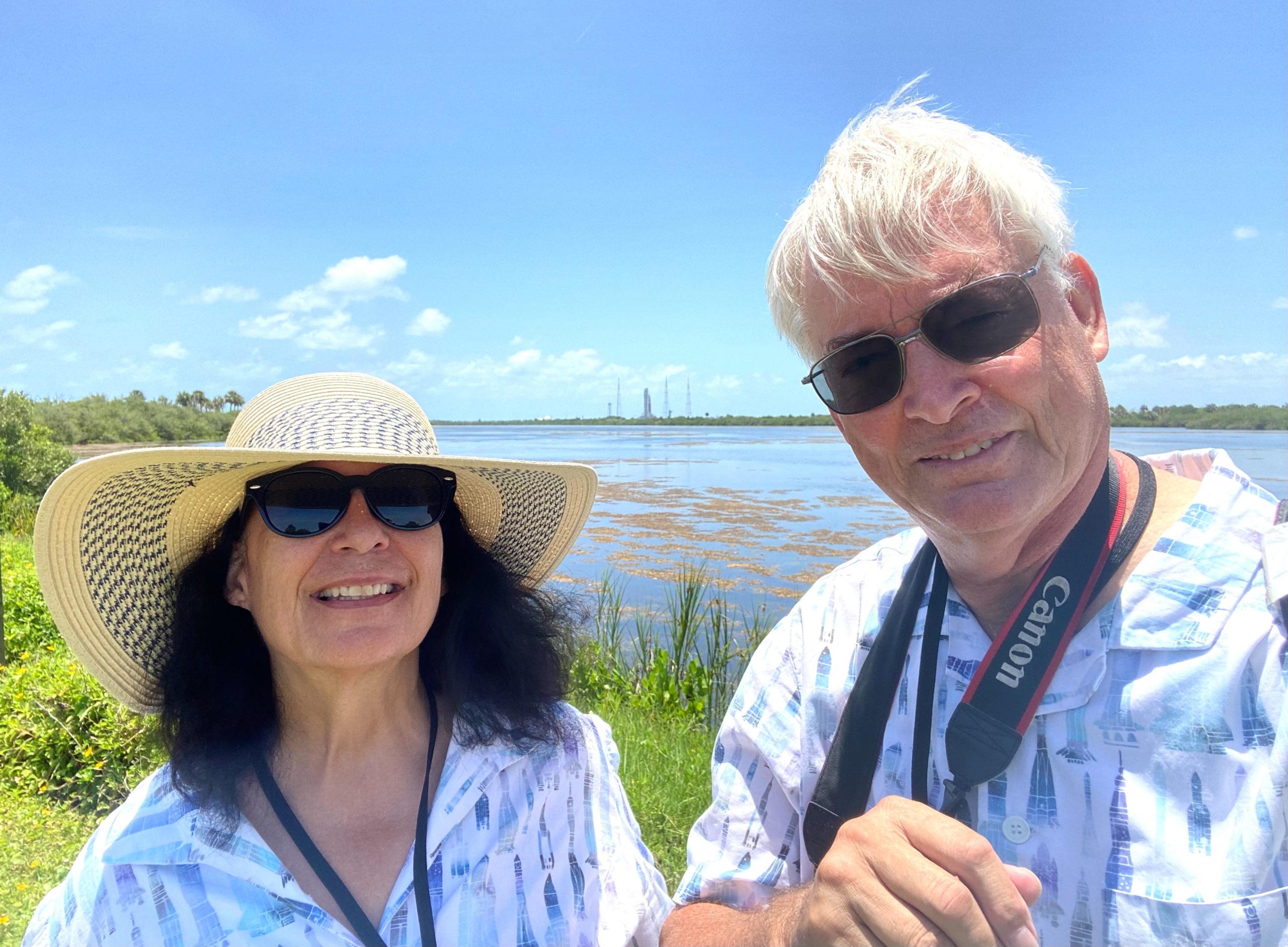
x



